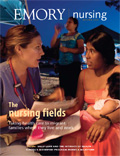Rewriting the book on quality and safety
QSEN is changing how schools teach
|
|

The Emory nursing students, short on sleep and long on enthusiasm, thought they could solve one of their own problems. They needed a topic to study for a project on quality improvement in their Professional Development course. They decided to assess themselves and test whether an intervention would improve their sleep.
They looked at previous research on the effects of inadequate sleep, made a fishbone diagram of all the factors that affect sleep duration, and then tracked their own sleep for two weeks. During week one, they limited watching television and using cell phones prior to bedtime. During week two, they instead tried dimming the lights for 30 minutes prior to sleep.
They plotted their findings in a run chart, which showed them that neither course of action resulted in significantly longer sleep for any of them. While they didn't find their proverbial warm glass of milk, their study was a fitting example of how nursing education across the United States is changing and how the nursing school is helping set the agenda.
The students' study is one way that quality and safety competencies are being incorporated into the nursing curriculum. As health care has worked to improve its systems to avert quality and safety problems, nursing schools have seen the need to educate students on quality and safety competencies before they enter the workforce. Fifteen nursing schools, including Emory's, have been selected by the Quality and Safety Education for Nurses (QSEN) project to help develop a new model for nursing education. The project has defined the quality and safety competencies needed, and now educators at each of the selected schools are testing ways of teaching them.
"Many of us were educated in a system where safety and quality were focused on individual performance," says Gerri Lamb, a visiting scholar, who spearheaded incorporating QSEN across the School of Nursing's undergraduate courses. "We were stuck in a blame-and-shame culture. Now we are creating environments that allow people who’ve made a mistake to come forward in order to improve processes. Our students are being prepared to step into these environments and be part of interdisciplinary teams focused on improving quality and safety."
Building Teamwork
Of the quality and safety improvements, Emory chose to focus on helping students develop and practice effective teamwork. During an interprofessional team training day, both nursing and medical students learned advanced team communication, followed by a simulation in which students role-played and assessed themselves and their teams.
Lamb worked with more than 30 faculty members to integrate QSEN knowledge and skills across classroom and clinical settings. She also had an advisory group of more than a dozen students to give feedback on whether they were recognizing the competencies. Students learned the concepts in class, and faculty then relayed in a weekly email to the clinical instructors what competencies were addressed so they also could highlight them. In return, students got more out of their clinical work.
"Students noticed quality and safety indicators in clinical practice in more specific and meaningful ways," says faculty member Corrine Abraham. "Our clinical preceptors told me that since students knew about quality improvement they were able to talk with them about specific initiatives in their units."
Before the competencies were integrated into coursework and clinical practice, "students would see quality improvement charts in their clinical settings and not know what they were," Lamb says.
A survey sent to graduating seniors in the spring showed that the students understood the value of the competencies and felt prepared to perform them in the workplace. Now faculty are working to introduce the quality and safety competencies in the junior year. That's a good move, as they soon will be required for all undergraduates by the American Association of Colleges of Nursing.
Says Associate Dean for Education Marsha Lewis, "We are ahead of the game in the undergraduate program as we integrate quality and safety more thoroughly into our curriculum."



